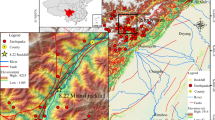Abstract
Multiple carbonate cliffs are distributed in the karst mountain areas of southwestern China. The dynamic process and failure mechanism of rockfalls in the cliffs are complicated and undefined, and can be dangerous for settlements. Moreover, it is difficult to identify the potential for such failures before they occur. The rockfall of the Zengziyan cliff at Chongqing, China, is used as an example for studying this type of failure and to determine the developmental characteristics of rockfall, expounding on the evolving process from a cliff to an unstable rock mass through to rockfall. A fracturing–crashing failure mode is proposed, based on the evolutionary characteristics of damage development, compression-induced fracturing, rock mass crashing and overall rockfall. Finite difference numerical simulations were used to analyse and validate the failure mode of the Zengziyan cliff under three simulation conditions. The results of the simulations indicated that strength deterioration at the bottom of the cliff was the root cause of its fracturing–crashing rockfall. The outcomes of this paper could provide a new analytical model and theoretical basis for identifying and analysing similar types of geological disasters in the mountainous areas of southwestern China, and may provide valuable reference information for further mechanical analysis, stability evaluation and engineering prevention of unstable rock masses prone to a fracturing–crashing rockfall.














Similar content being viewed by others
References
Feng Z, Li B, Cai Q and Cao J 2016 Initiation mechanism of the Jiweishan landslide in Chongqing, south-western China; Environ. Eng. Geosci. 22 34–351.
Frayssines M and Hantz D 2006 Failure mechanisms and triggering factors in calcareous cliffs of the subalpine ranges (French Alps); Eng. Geol. 86 256–270.
Glastonbury J and Fell R 2008 A decision analysis framework for the assessment of likely post-failure velocity of translational and compound natural rock slope landslides; Can. Geotech. J. 45 329–350.
He K, Chen C and Li B 2018 Case study of a rockfall in Chongqing, China: Movement characteristics of the initial failure process of a tower-shaped rock mass; Bull. Eng. Geol. Environ., https://doi.org/10.1007/s10064-018-1364-9.
Hoek E and Bray J 1977 Rock slope engineering (2nd edn); Institution of Mining & Metallurgy, London.
Huang B, Yin Y, Liu G, Wang S, Chen X and Huo Z 2012 Analysis of waves generated by Gongjiafang landslide in Wu Gorge, three Gorges reservoir, on November 23, 2008; Landslides 9 395–405.
Huang R 2012 Mechanisms of large-scale landslides in China; Bull. Eng. Geol. Environ. 71 161–170.
Hungr O 1981 Dynamics of rock avalanches and other types of slope movements; PhD Thesis, University of Alberta, Edmonton, 500p.
Hungr O and Evans S G 2004 The occurrence and classification of massive rock slope failure; Felsbau 22 16–23.
Hungr O, Evans S G, Bovis M and Hutchinson J N 2001 Review of the classification of landslides of the flow type; Environ. Eng. Geosci. VII 221–238.
Hungr O, Leroueil S and Picarelli L 2014 The varnes classification of landslide types, an update; Landslides 11 167–194.
Jones D B, Siddle H J, Reddish D J and Whittaker B N 1992 Landslide and undermining: Slope stability interaction with mining; In: Proceedings of the 7th International Society of Rock Mechanics congress, Aachen, pp. 893–898.
Keiler M and Fuchs S 2016 Vulnerability and exposure to geomorphic hazards: Some insights from the European Alps, Geomorphology and Society; Springer, Tokyo.
Li B, Feng Z, Wang G and Wang W 2016 Processes and behaviors of block topple avalanches resulting from carbonate slope failures due to underground mining; Environ. Earth Sci. 75 694–720.
Peisser C D, Helmstetter A, Grasso J R, Hantz D, Desvarreux P, Jeannin M and Giraud A 2002 Probabilistic approach to rock fall hazard assessment: Potential of historical data analysis; Nat. Hazards Earth Syst. 2 15–26.
Poisel R and Eppensteiner W 1988 A contribution to the systematics of rock mass movements; In: 5th international symposium on landslides, Lausanne, pp. 1353–1357.
Poisel R, Steger W and and Zeitler A 1991 Stability investigations of competent rock masses lying on an incompetent base; In: 7th ISRM Congress, International Society for Rock Mechanics, pp. 939–944.
Poisel R, Martin B, Rudolf H and Pavel L 2005 Geomechanics of hazardous landslides; J. Mt. Sci. 2 211–217.
Susan L N, Hungr O and Evans S G 2002 Large-scale brittle and ductile toppling of rock slopes; Can. Geotech. J. 39 773–788.
Terzaghi K 1950 Mechanism of landslides; The Geological Society of America, America, pp. 83–123.
Yin Y, Huang B, Liu G and Wang S 2015 Potential risk analysis on a Jianchuandong dangerous rockmass-generated impulse wave in the Three Gorges Reservoir, China; Environ. Earth Sci. 74 2595–2607.
Yin Y, Sun P, Zhang M and Li B 2011 Mechanism on apparent dip sliding of oblique inclined bedding rockslide at Jiweishan, Chongqing, China; Landslides 8 49–65.
Acknowledgements
This study was conducted with the financial support from the National Natural Science Foundation of China (No. 41702342) and National Key R&D Program of China (2018YFC1504806, 2018YFC1504805).
Author information
Authors and Affiliations
Corresponding author
Additional information
Corresponding editor: Arkoprovo Biswas
Rights and permissions
About this article
Cite this article
He, K., Yin, Y., Li, B. et al. The mechanism of the bottom-crashing rockfall of a massive layered carbonate rock mass at Zengziyan, Chongqing, China. J Earth Syst Sci 128, 104 (2019). https://doi.org/10.1007/s12040-019-1141-6
Received:
Revised:
Accepted:
Published:
DOI: https://doi.org/10.1007/s12040-019-1141-6




